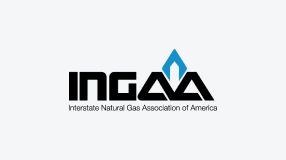Foundation Resources
The electric power industry is preparing for a rise in customer demand and major urban load centers are requiring more electricty. As electric demand in urban areas rises, congrestion on the electric transmission system may increase. This study [...] Read More
This report provides a summary and analysis of the strategic, engineering, and economic factors that currently influence the selection of eletric motor drives (EMD) for natural gas compressors, and provides an industry-based consensus on the future [...] Read More
Building a natural gas pipeline requires careful review of whether the construction, operation and maintenance of the facility will affect water quality, cultural and historic resources, air quality, threatened and endangered species and many other [...] Read More
In January 1999, the INGAA Foundation’s study, Pipeline and Storage Infrastructure Requirements for a 30 Tcf U.S. Gas Market, outlined the promise and the challenges of an unprecedented 30 trillion cubic foot natural gas market in the U.S. by [...] Read More
The Natural Gas Act authorizes the construction and operation of interstate natural gas pipelines, with regulatory oversight by the Federal Energy Regulatory Commission (FERC). Since these activities are performed under the authority of the Federal [...] Read More
Distributed generation has captured the interest of federal and state policymakers, excited potential developers and users and is becoming a part of the business strategies of utilities and other energy service providers. It has the potential to [...] Read More
Over the past decade perhaps no external factor has influenced the energy industry more than technology. From the wide spread use of automated real-time telemetry to using the Internet to conduct daily operations such as nominations, [...] Read More
More than 500 new gas-fired generation projects are in various stages of consideration or development around the country. The capacity of these proposed projects totals some 280,000 megawatts, an increase of more than 35 percent of the currently [...] Read More
Natural gas plays a prominent role in our nation’s energy mix; it is the fuel of choice for the rapidly expanding U.S. electricity generation market. Rising consumer demand, national security concerns, environmental needs and economic [...] Read More
Recent right-of-way rental fee proposals by the U.S. Bureau of Land Management (BLM) could increase fees for natural gas pipelines by more than 100 times, which could negatively impact national security, the successful implementation of the U.S. [...] Read More
Introduction In September 1999 the Federal Energy Regulatory Commission (FERC) issued Order No. 608 that set out a voluntary program for increasing stakeholder involvement in pre-application activities by allowing applicants, at their [...] Read More
During the 1990s, there was a major effort to develop, demonstrate and improve natural gas-based emission control technologies for coal-fired power plants. The two primary technologies are gas cofiring and gas reburn. The purpose of this [...] Read More
Over the past decade, perhaps no external factor has influenced the energy industry more than technology. From the wide spread use of automated real-time telemetry to using the Internet to conduct daily operations such as nominations, [...] Read More
This natural gas pipeline impact study has been conducted at the request of the Interstate Natural Gas Association of America Foundation (INGAA Foundation). In order to determine the impact of natural gas pipelines on real estate, several objectives [...] Read More
In January 1999, the INGAA Foundation published Pipeline and Storage Infrastructure for a 30 Tcf Market. The report was the first in a series of studies examining the opportunities and challenges facing the natural gas industry in serving the [...] Read More
Policymakers been systems, looking particularly at new integrity inspections. One of the key questions being raised in these forums is whether there should be a specific integrity inspection interval for natural gas pipelines, and if so, what the [...] Read More
The Gulf of Mexico is one of the nation's most important natural gas supply areas. Offshore production in the Gulf provides U.S. markets with 26.5 percent of indigenous gas supplies, and forecasters are predicting significant increases in U.S. gas [...] Read More
The Interstate Natural Gas Association of America (INGAA) Foundation commissioned ENSR International (ENSR), an environmental consulting firm, to undertake a study to solicit, assimilate, and present the natural gas transmission Industry reactions [...] Read More
Natural gas provides 25 percent of the basic energy needs in the U.S., but many consumers are unfamiliar with the pipeline industry that ships that natural gas. The 32 INGAA member companies that operate the 180,000-mile underground interstate [...] Read More
Wirthlin Worldwide’s research conclusions and strategic recommendations comprise what we consider a meaningful paradigm shift in the natural gas industry’s approach to siting pipelines in the United States. This enhanced approach [...] Read More


